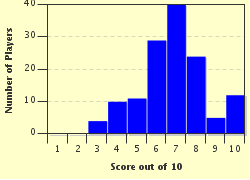Quiz Answer Key and Fun Facts
1. Sheep show emotion by the position of their ears but which of the following is NOT a typical ear posture?
2. Research has found that sheep are capable of facial recognition.
3. Sheep will "self-medicate" by doing which of the following?
4. Sheep have a high tolerance for pain and a weak or sick sheep will "pretend" to be healthy for its own protection, however which following would indicate a sheep in distress?
5. Sheep are very social animals and need visual contact with each other in order to prevent which of the following?
6. Why are sheep reluctant to go where they can't see?
7. Sheep have excellent hearing which enables them to pinpoint sound.
8. Sheep also have an excellent sense of smell and their olfactory system is more highly developed than humans.
9. Icelandic leadersheep are highly intelligent and have been known to do all but which of the following?
10. Are sheep tracks parallel and straight or winding?
Source: Author
sally0malley
This quiz was reviewed by FunTrivia editor
guitargoddess before going online.
Any errors found in FunTrivia content are routinely corrected through our feedback system.


